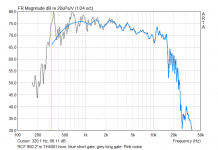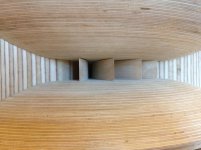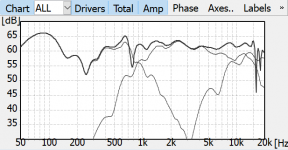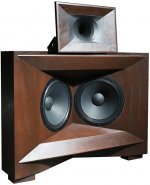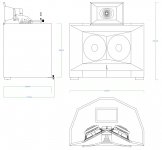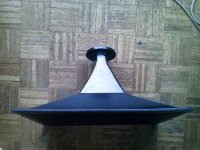I was just comparing figures in WinIsd and by using an added Active Radiator I can hit about 117db @ 30hz using 18H+, in a 500liter closed cab...which is shy of the 120ish I'd get with an 18H+ in a reflex but the idea that the clarity is going to be that much higher, is worth it. To use a passive radiator for an 18" driver would require almost the same investment in passive radiators than it would cost for an Active Radiator....Qtc seems largely unaffected, the power handling is raised, excursion is lowered, heat in voice coils lowered, etc.... kind of a no brainer~!
I think an active radiator idea is powering a dual voice coil woofer on one set of coils, and connecting to another woofer from the unused set of coils.
No idea of the outcome, it was posted on here some time back but didn't come up on a search.
No idea of the outcome, it was posted on here some time back but didn't come up on a search.
I think most people would call this 2 drivers in a box 😉What is Active Radiator Technology? Any references, links?
//
Crossover not yet ready (we used simple 2nd order). First feeling wow but after few minutes I was tired. I still prefer ESL57.
IMG_1051.MOV - Google Drive
IMG_1051.MOV - Google Drive
Tired ?
It can be hard to get away from time alignment / phase alignment.
Point source rings many people bells too.
It can be hard to get away from time alignment / phase alignment.
Point source rings many people bells too.
Too loud, fatigue especially trumpet (old italian music). It was very rush crossover. I will repeat within few weeks measurements - plus near filed, BR port. To lower floor reflection at 200Hz place woofer so that ceiling and floor are equal distance?
WhatsApp Video 2020-03-16 at 20.27.49.mp4 - Google Drive
WhatsApp Video 2020-03-16 at 20.27.49.mp4 - Google Drive
J, there seems to be a little too much energy between (roughly) 1.5 and 5k. The peaks are likely to boost listening fatigue even more. There's probably also too much output in the top octave for a small room. I suggest to bring those 2 areas down, PEQ the peaks and listen again 🙂
Last edited:
Sounds as if your tweeter plays some 10-12 dB too loud: even on my crummy laptop audio it sounds ear-splitting. No wonder you yearn for your ESL 57..
Sounds as if your tweeter plays some 10-12 dB too loud: even on my crummy laptop audio it sounds ear-splitting. No wonder you yearn for your ESL 57..
Levels ok, crossover from parts we had. ESL57 - very good tonality and natural timbre, try listen to clapping hands. Horns - feeling of mechanical sound. Within few weeks will repeat measurements and make better crossover.
chebum - different rooms.
Attachments
Some comments from another thread:
"I did try ruler flat at first but it was definitely way too bright. I took down 2k-10k by 2dB. 10-16k has a 1dB drop. Sounds the most natural on a wide variety of recordings and genres."
"I worked at a very well-known recording studio in the 80's and recall that we intentionally rolled off the high end when "voicing" a control room. I believe it was 3 db per octave above 6.3 KHz, a gentle slope that cured the "harshness" of the TAD compression drivers that were in vogue at the time."
"I did try ruler flat at first but it was definitely way too bright. I took down 2k-10k by 2dB. 10-16k has a 1dB drop. Sounds the most natural on a wide variety of recordings and genres."
"I worked at a very well-known recording studio in the 80's and recall that we intentionally rolled off the high end when "voicing" a control room. I believe it was 3 db per octave above 6.3 KHz, a gentle slope that cured the "harshness" of the TAD compression drivers that were in vogue at the time."
Additionally, the selection (and quality of) passive crossover components can make a big difference in the "voicing" of a compression driver. It's what makes or breaks a loudspeaker system according to Tony Gee, Jürgen Strauss, Thomas Blumenhofer et al. The latter uses almost exclusively RCF drivers for his horn loudspeakers.
Last edited:
Check hifi setting of Barefoot MM27, one of the most popular studio monitor last 15 years. BBC dip (or I call it B&W curve).
https://barefootsound.com/wp-content/uploads/2014/06/Barefoot_MicroMain27_Gen2_Users_Manual.pdf
I have been using this monitor for production monitoring, but with its flat setting, it is not suitable to listen to post-mastering materials everyday at home. Mastering usually makes music brighter than master tape.
https://barefootsound.com/wp-content/uploads/2014/06/Barefoot_MicroMain27_Gen2_Users_Manual.pdf
I have been using this monitor for production monitoring, but with its flat setting, it is not suitable to listen to post-mastering materials everyday at home. Mastering usually makes music brighter than master tape.
Last edited:
Another interesting 2 way:
30Hz - 20kHz ± 2dB, 4" Beryllium dia on 2" throat + 2 x 15", XO @ 850 Hz and 'only' 180 kg.
The top horn actually consists of an elliptical throat transition to a BMS 2236-type mouth section (last 2 images).
30Hz - 20kHz ± 2dB, 4" Beryllium dia on 2" throat + 2 x 15", XO @ 850 Hz and 'only' 180 kg.
The top horn actually consists of an elliptical throat transition to a BMS 2236-type mouth section (last 2 images).
Attachments
Last edited:
Another interesting 2 way:
30Hz - 20kHz ± 2dB, 4" Beryllium dia on 2" throat + 2 x 15", XO @ 850 Hz and 'only' 180 kg.
The top horn actually consists of an elliptical throat transition to a BMS 2236-type mouth section (last 2 images).
To me, that's ugly as hell, but... beauty is in the eye of the beholder, so what do I know? 🙂
- Home
- Loudspeakers
- Multi-Way
- Is it possible to cover the whole spectrum, high SPL, low distortion with a 2-way?
